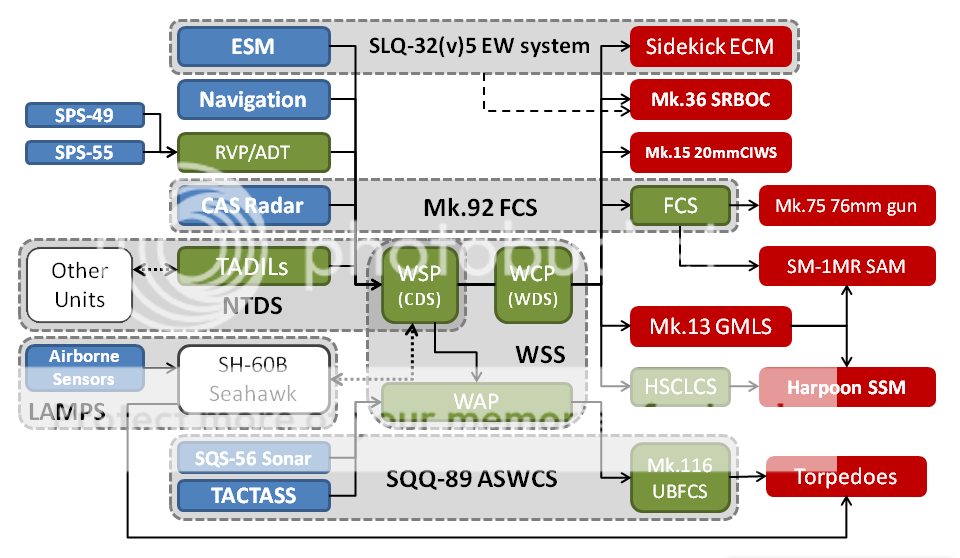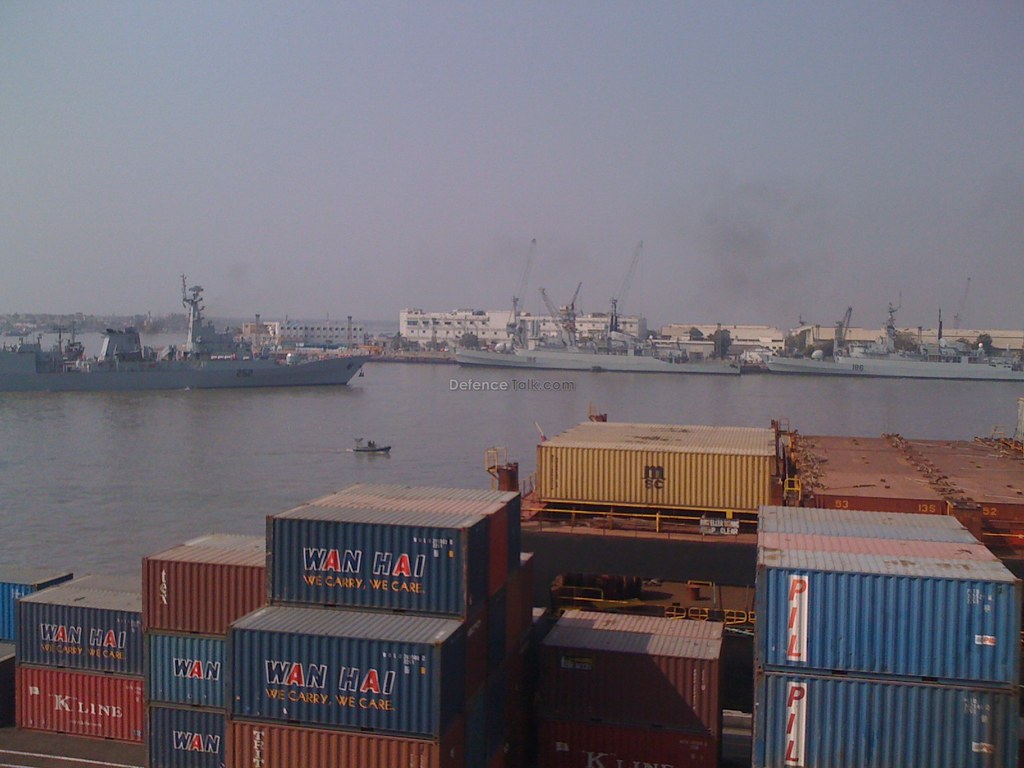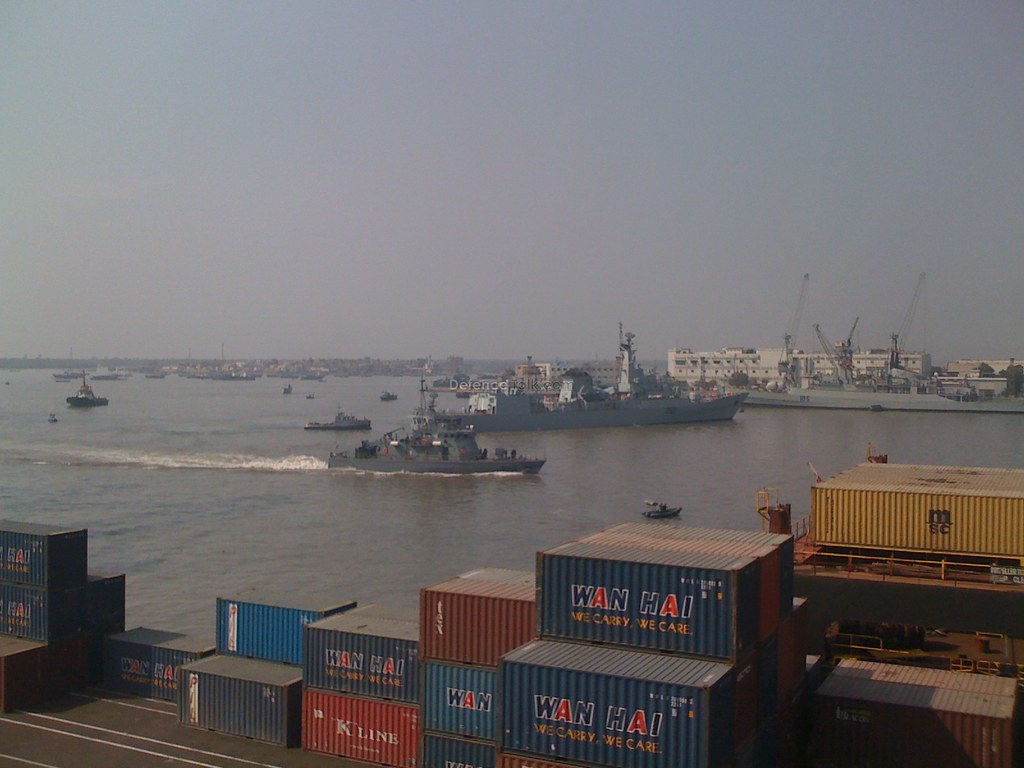Pakistan acquired the six surviving examples of the UK Royal Navy's (RN) Type 21 Amazon class frigates in 1993. The first, PNS Tariq (formerly HMS Ambuscade) was commissioned in July of that year. In 1995, it was revealed that these 20-year-old ships, renamed Tariq class "destroyers" by their new owners, are to benefit from a major upgrade program.
The Type 21 was conceived in the mid-1960s to replace diesel-engined air-defence frigates of the Leopard (Type 41) and Salisbury (Type 61) classes. Unlike previous - and subsequent - British warships, they were designed by private shipbuilders to slightly less than RN standards. The objective was to produce an inexpensive frigate, which would secure export contracts.
The Royal Australian Navy, which was interested in the design and considered building five, provided up to a third of the design funding. In the event, inflation and the need to ensure the design met naval standards in key areas meant the first ship cost nearly four times what was orignally planned, and no export contract was ever awarded.
British configuration
Designed by Vosper Thornycroft and Yarrow from 1968, the Amazon class were the first custom-built frigates with gas-turbine propulsion. The first-of-class, HMS Amazon, was launched in 1971 and commissioned in May 1974. The vessels featured COGOG (combined-gas-or-gas propulsion). Although they handled easily, doubts were raised about the use of an all-aluminium superstructure to increase weapon load while reducing top weight. A fire in Amazon in 1977 caused severe damage; all later British frigates reverted to a steel superstructure.
The surface-sensor suite comprised the Marconi Type 992Q E/F-band (2-4GHz) search and target-indicator radar with a 6.4m-long slotted waveguide; the Decca (now Racal-Decca) Type 978 I/J-band (8-12GHz) navigation radar (later replaced by the Kelvin Hughes Type 1006 I-band system); and - to cut costs - the Italian Selenia (now Alenia) RTN-10X I-band (8-10GHz) conical-scan fire-control radar was acquired as Type 912.
The Type 992 produces a 1.25x15 beam with a peak power of 2MW, a pulse width of 2s and pulse-repetition frequency (PRF) of 750pps, with an effective range against an air target of 90nm (165km). The Type 912, with slatted parabolic antenna and feed, and television camera backup, has a peak power of 200kW, a pulse width of 1.5s and a PRF of up to 550pps. It can detect targets at ranges up to 35nm (65km). The electronic-support measures (ESM) suite was the MEL UAA-1 Abbey Hill operating in the 1-18Ghz range with instantaneous frequency measurement and a direction-finding accuracy of 3.5.
The two hull-mounted underwater sensors are the Kelvin Hughes Type 162M classification sonar and the Graseby Type 184. The Type 162M operates at 50kHz and is designed to detect submarines on the ocean floor. Three strip transducers produce fan-shaped 3x40 beams at ranges under 0.7nm (1.2km). The Type 184 has a circular 1.2m diameter 32-stave transducer and operates at 7.5kHz. This produces up to four beams, creating a 45 "searchlight arc" and the display system, which has torpedo-warning capability, can automatically track two targets.
The command and weapon-control system was the Ferranti (now Marconi S3I) Computer Assisted Action Information System, known as Outfit DBA 2, with Ferranti WSA-4 fire-control system. Both are mainframe systems based on the Ferranti FM 1600B 24-bit computer, using Coral 66 language software, with an operating speed of 200,000 operations/s and a memory of 780k. Outfit DBA had Decca navigation radar displays; WSA-4 had a four-man console.
The weapon system was disappointing, possibly due to difficulties in reducing weight and cost. The ships were originally fitted with the VSEL 4.5in (113mm) gun and the Shorts GWS 24 Seacat short-range (2.7nm or 5km) air-defence missile system, although they embarked a Wasp anti-submarine warfare (ASW) helicopter (later a Lynx).
From the third ship (Active) onwards, the GWS 50 (Aerospatiale MM38 Exocet) surface-to-surface missile (with a range of 22.5nm or 42km) was installed. The Plessey STWS-1 lightweight torpedo-launching system was installed in Active and Alacrity. Amazon and Ambuscade did not receive Exocets until 1985, and the remainder of the class, which did not receive STWS-1, was fitted with four 20mm Oerlikon Mk7A gun mountings instead. Decoy systems consisted of the Graseby Type 182 towed anti-torpedo unit and Vickers Corvus trainable, anti-missile munition launchers.
The weapons fit was little better than that of the improved Leander class of the early 1960s. However, design limitations and the reported overweight and top-heavy delivery (forcing ballast to be added) meant there was little room for improvement. Plans existed to install the British Aerospace Seawolf surface-to-air missile, with twice the range of Seacat and an anti-missile capability, but it was concluded this would adversely affect stability. In 1980, the RN announced the Amazon class would not receive a mid-life update, although plans existed to replace the search radar with Type 996 later in the decade.
Six of the eight ships participated in the 1982 Falklands (Malvinas) war. Antelope and Ardent were sunk by Argentine bombs, while Arrow suffered structural damage. Also, there was severe cracking in the upper deck structure due to environmental conditions in the South Atlantic. From 1983, large strengthening plates were added amid ships, increasing displacement by 350t. The last work done on these vessels by the RN (from 1988) was the modification of the hull to reduce noise and vibration.
Given the problems of upgrading these ships, it is surprising that the Pakistan Navy is embarking upon so radical a programme. The Amazon class was acquired to replace eight Garcia and Brooke class frigates leased from the United States; the last was commissioned in September 1994. At that time, the Pakistan Navy had a variety of warships, including two former RN Leander class frigates, a County class destroyer and five 40-year-old US Gearing class destroyers.
By retiring the Garcia and Brooke class (with their complex steam turbines), decommissioning three Gearings and the County class ship, then acquiring the Amazons, the Pakistan Navy has simplified its logistics infrastructure and reduced personnel levels by up to 3,000. A chief drawback of the new ships was their 1960s sensor and weapons fits, but the need to make effective use of these "destroyers" provided an upgrade imperative missing from the RN.
New sensor mix
The Type 912 (RTN-10X), although old, remains an effective sensor. However, the Type 992 (development of which began in 1948) required urgent replacement. The Signaal DA 08 has been selected, and six new systems have been ordered.
The DA 08 is a coherent pulse-compression E/F-band (2-4 GHz) radar with stabilised antenna, dating back to the late-1970s. Each pulse consists of a 1s non-modulated and one 34s or 68s frequency-swept element with PRFs of 1,000 and 500pps, respectively, while the scan rate is either 10 or 20rpm. Resolution is 1.5 in azimuth and 120m in range, providing greater accuracy and better electronic-countermeasures performance, although the range against a 2m2 object is virtually the same as the earlier sensor. As the radar had already been upgraded to digital format by the RN the displays will be compatible with the new radar.
Complementing these electronic sensors will be a CS Defense Najir Mk2 electro-optical director. This is a remotely operated unit equipped with a SAT Murene thermal imager, Radamec HK 202 television camera and CILAS THS 304 laser rangefinder. It is capable of controlling the fire of two guns of different calibres. Only three systems have been acquired and it is unknown whether options exist for another three.
The elderly UAA-1 ESM system has been replaced by a Thomson-CSF DR 3000S suite. This uses new technology including a low-noise amplifier in the antenna to achieve higher sensitivity and better direction-finding accuracy, usually less than 1. The instantaneous frequency measurement is fast enough to operate within a pulse or sub-pulse basis and with an accuracy to within a few MHz. The improved processor can automatically handle up to 256 series of pulses and the system has a large library. Installation of the DR 3000S system will, however, require the mast to be shortened.
Pakistan should reap considerable operational and economic benefits by having common software for its electronic-warfare (EW) systems, given purchase of the same system for maritime-patrol aircraft and the possibility of similar acquisitions for three new French-built submarines.
The BAeSEMA/Thomson Sintra ATAS active towed-array sonar has been fitted into two of the ships and another two systems might be installed. (This would be consistent with the acquisition of four new command systems.) There are reports that the Type 184 sonar may be upgraded, possibly with improved processing. Whether this happens remains to be seen, but it seems logical as this would be cheaper than replacing the sonar.
Improvements in sensors will be matched by replacing the 30-year-old technology in the command-and-weapon-control system with a new-generation CelsiusTech 9LV Mk3. This system usually has its own radar director. CelsiusTech of Sweden, responsible for installing its 9LV Mk3 command system in the former-RN Type 21 frigates purchased by the Pakistan Navy, has awarded Park Air Electronics (PAE) of the UK a contract to refurbish and upgrade the radio communications.
The heart of the system will be PAE's Outfit 1207 V/UHF AM/FM transceivers. These were developed by the company to be form-fit-function compatible with the Outfit 1203, already on the vessels. These will be supplied to Pakistan to provide frequency-agile UHF voice communications, in concert with the Link Y encrypted data messages system, with interfaces to other communications elements in the network.
The refurbishment programme comprises multi-channel voice and data links in HF, VHF and UHF bands, with frequency-agility where appropriate, for surface-to- air, ship-to-ship and ship-to-shore communications. In addition, PAE will supply Type 3030 UHF, frequency-agile transceivers for use as base stations on shore.
The Type 21s will be fitted with the CelsiusTech 9LV Mk3 command, control and communications (C3) system, which is a fully-distributed processor system programmed in Ada, at the Naval Dockyard in Karachi. The contract includes a Naval Headquarters C3 System as well as equipment for a training centre.
The 9LV Mk3 uses distributed architecture based on the 32-bit Motorola 68000 family of microprocessors and Ada software. The system operates faster, and with a much larger memory, including 4Mb RAM and 256k EPROM, making it much more capable than its predecessor. The main hardware consists of multirole workstations which are software-driven and linked by an Ethernet-standard local-area network to provide greater flexibility. Some of the existing displays will be retained.
Revised firepower
The Pakistan Navy has offset the cost of new electronics by transferring weapons from decommissioned destroyers. The RN's Exocet systems were removed before the ships were transferred, and are being replaced with Harpoon Block IC missiles. These have longer range (124km) and greater capability, including a capacity for indirect attack and re-acquiring targets. The missiles are from the Gearings, as is the Phalanx Mk15 close-in weapon system (CIWS), which replaces Seacat. The ships will be equipped with the Mk36 SRBOC (super rapid bloom, offboard, countermeasures) decoy launcher, which has a wider range of munitions than the Corvus.
The most interesting of the weapons is the newly acquired Bofors Underwater Systems Tp45 (formerly known as Tp43X2) lightweight torpedo. This is the first sale of the system outside Scandinavia. These are wire-guided, electrically powered weapons optimised for use against quiet submarines in shallow water.
Developed for the Royal Swedish Navy, the 400mm diameter Torpedo 43X2 combines wire guidance (allowing for two-way data transmission between the launch platform and the torpedo prior to the terminal homing phase) with a hydro-acoustic homing head. For ship-launch Torpedo 43X2 is fired from a high pressure compressed air launcher which can be mounted in single to quadruple configurations. The 50kg warhead has both impact and proximity fuzes. The use of wire-guided weapons is surprising as it restricts ship performance in open water. Quadruple-launchers will be installed on four of the six ships, but may not replace STWS-1 in the two non-modernised ships, possibly Badr and Shahjahan.
While the rest of western forces have standardised on 324mm diameter lightweight torpedoes, Sweden's Bofors Underwater Systems continues to develop its line of 400mm weapons for ship-, submarine- and air-launched applications. The current in-service weapon, the wire-guided Torpedo began development in 1990 and represents the fourth generation of 400mm weapons used by Sweden.
Torpedo 43X2 is itself an upgrade of the earlier 43X0, replacing the earlier homing head with a new multimode (active, passive and simultaneous active/passive) transducer and signal processor essentially identical to that fitted to the new torpedo 2000 heavyweight. Optimised for shallow water conditions, it is claimed to be able to track multiple targets against a background of environmental noise and acoustic countermeasures. Power is supplied by an Ag-Zn battery unit feeding a geared DC electric motor via a thyristor switch. One of three alternative run speeds can be selected.
The installation of Phalanx and SRBOC underlines Pakistan's concerns about a major weakness of this class: its poor air-defence capability, which has been aggravated by the removal of Seacat. When acquired, the frigates had two, or four, Mk7A 20mm Oerlikon mountings of Second World War vintage, and there were reports that two twin 30mm Royal Ordnance GCM-AO3 and two single 20mm RO GAM-BO1 would be fitted. Industrial sources now say that Pakistan has ordered the MSI Defence DS30B mount with a single 30mm Oerlikon KCB, although the company refuses to comment.
Defensive role
According to industry sources, only three sets of the DS30B will be fitted in those ships with the new Najir directors. It seems likely that, on deployment, the frigates will carry a party of marines with man-portable surface-to-air systems (such as Stinger) but MSI does offer the SIGMA gun/missile combination, which is compatible with Stinger. The same limitations which prevented the British installing Seawolf seem likely to prevent replacement of the surface-to-air missile system.
The Tariq class has a defensive role which reaches a little beyond the narrow continental shelf, and there is equal emphasis upon the anti-surface warfare (ASuW) and ASW tasks. Given Pakistan's dependence on maritime oil deliveries, and the threat posed by India's force of eight Kilo class and four Type 209/1400 diesel-electric submarines, the ASW role is understandable.
The ASuW role must be viewed in light of Pakistan's recent naval experience: in December 1971, Indian fast attack craft attacked Karachi with SS-N-2 Styx missiles, causing great damage and sinking the destroyer Khaibar, the minesweeper Muhafiz, and several merchant ships.
The Tariq class is subject to a modular upgrade in which all ships receive new radars and EW systems, but command/weapon control, sonar, ASW and gun-system upgrades will vary from ship to ship. It is unclear which ships will receive which equipment, and no programme start dates have been revealed.
Britain's Devonport Management Limited recently received a US$530,000 contract from CelsiusTech to assist in integrating the command system, which suggests the programme will begin later this year. Curiously, industrial sources say that Pakistan may issue a consultancy contract to foreign firms about the future roles of these ships.
Nevertheless, by a judicious mix of new acquisitions and recycling of existing equipment, the Pakistan Navy has adopted a cost-effective solution to extend the Tariq class frigates' operational life well into the next century.













































